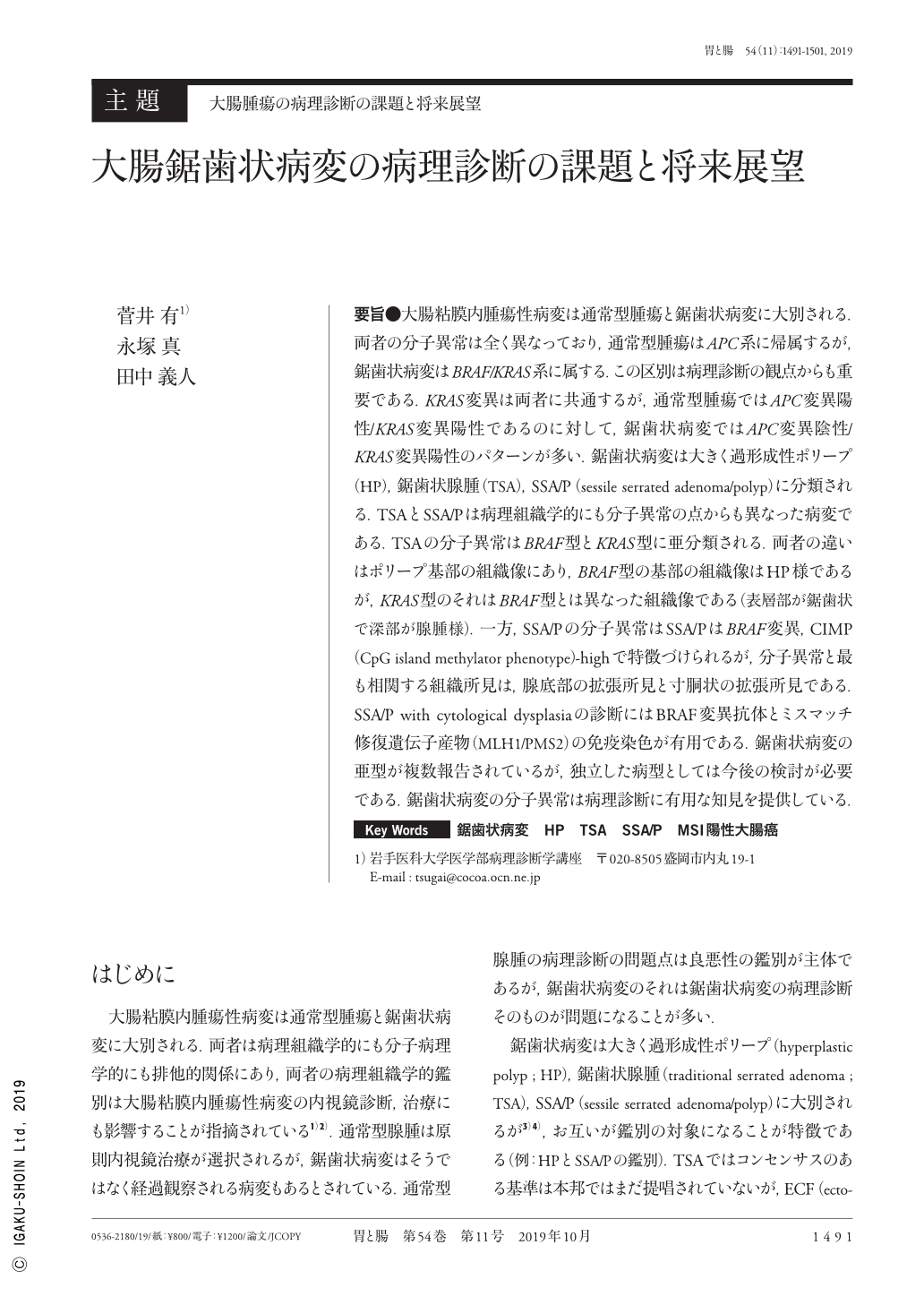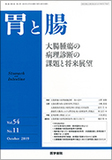Japanese
English
- 有料閲覧
- Abstract 文献概要
- 1ページ目 Look Inside
- 参考文献 Reference
- サイト内被引用 Cited by
要旨●大腸粘膜内腫瘍性病変は通常型腫瘍と鋸歯状病変に大別される.両者の分子異常は全く異なっており,通常型腫瘍はAPC系に帰属するが,鋸歯状病変はBRAF/KRAS系に属する.この区別は病理診断の観点からも重要である.KRAS変異は両者に共通するが,通常型腫瘍ではAPC変異陽性/KRAS変異陽性であるのに対して,鋸歯状病変ではAPC変異陰性/KRAS変異陽性のパターンが多い.鋸歯状病変は大きく過形成性ポリープ(HP),鋸歯状腺腫(TSA),SSA/P(sessile serrated adenoma/polyp)に分類される.TSAとSSA/Pは病理組織学的にも分子異常の点からも異なった病変である.TSAの分子異常はBRAF型とKRAS型に亜分類される.両者の違いはポリープ基部の組織像にあり,BRAF型の基部の組織像はHP様であるが,KRAS型のそれはBRAF型とは異なった組織像である(表層部が鋸歯状で深部が腺腫様).一方,SSA/Pの分子異常はSSA/PはBRAF変異,CIMP(CpG island methylator phenotype)-highで特徴づけられるが,分子異常と最も相関する組織所見は,腺底部の拡張所見と寸胴状の拡張所見である.SSA/P with cytological dysplasiaの診断にはBRAF変異抗体とミスマッチ修復遺伝子産物(MLH1/PMS2)の免疫染色が有用である.鋸歯状病変の亜型が複数報告されているが,独立した病型としては今後の検討が必要である.鋸歯状病変の分子異常は病理診断に有用な知見を提供している.
Intramucosal colorectal neoplasia is classified into two subgroups:conventional and serrated. Although conventional neoplasia belongs to the types of cancers that arise from APC type, serrated neoplasia is subclassified as a BRAF/KRAS type of cancer. Whereas conventional type neoplasia is characterized by APC mutations/KRAS mutations, serrated neoplasia is closely associated with APC(−)/KRAS(+)mutations. In addition, BRAF mutations play an important role early in the development of serrated tumors. Thus TSA(traditional serrated adenoma)and SSA/P(sessile serrated adenoma/polyp) have different histopathological and molecular features. Histological characteristics of TSA include formation of villi at the surface, columnar cells with pencil-like nuclei and eosinophilic cytoplasm and budding(ectopic crypt foci). On the other hand, TSA is subclassified as a BRAF and KRAS type of cancer on the basis of histological differences in the polyp base. Histological diagnosis of SSA/P is based on the following criteria:(1)glandular dilatation, (2)asymmetric crypt branching, and(3)crypt dilatation or abnormal arrangement of the crypt base. Molecular alterations are characterized by BRAF mutations and CpG island methylator phenotype-high status. Molecular alteration is correlated with the third of the three criteria for SSA/P diagnosis. For pathological diagnosis of SSA/P with cytological dysplasia, it is useful to examine immunostaining of mutant anti-BRAF antibody and MLH1/PMS2 proteins. Several variants of serrate lesions, including superficial serrated adenoma, mucin-rich TSA, and serrated tubulovillous adenoma, have been reported. Such lesions must be examined further to establish the pathological entity. We suggest that the molecular alterations enable the pathological diagnosis of serrated lesions.

Copyright © 2019, Igaku-Shoin Ltd. All rights reserved.


